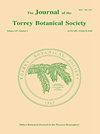利用ISSR标记推断佛罗里达苋科中心和边缘居群的原生性和生物地理亲缘性[j]
IF 0.8
4区 生物学
Q4 PLANT SCIENCES
引用次数: 20
摘要
和美国东南部。利用基于ISSR的遗传分析和植物标本室研究相结合的方法,对该物种的生物地理格局进行了分析,以回答有关其历史分布和近期范围扩展的一系列问题,并对俄亥俄州南部一个分离种群的关系进行了分析。遗传多样性的数量在物种范围的远北部和东北部的边缘种群中显着减少,对应于植物标本室记录显示该物种在过去100年中已经归化的地区。我们的分析表明,在这个多态物种复合体中可以识别出三个生物地理谱系:一个大平原谱系,一个相关的中西部密西西比谱系和一个大西洋沿岸平原谱系。这些谱系在分类学上被粗略地认为是变种:西部谱系为F. floridana var. campestris (Small) Fern。和东部血统的F. floridana var. florida (Nutt.)。Moq。然而,我们的数据表明,继续承认这些品种是不合理的。俄亥俄州的分离种群,以前被认为是曾经较大分布的残余,目前被列为国家稀有物种,显示出与最近在其他州建立的边缘种群相当的遗传多样性和分化模式,并且最有可能来自大平原或中西部血统。本文章由计算机程序翻译,如有差异,请以英文原文为准。
Inferring nativity and biogeographic affinities of central and marginal populations of Froelichia floridana (Amaranthaceae) from Inter-Simple Sequence Repeat (ISSR) markers1
and southeastern United States. We analyzed the biogeographic patterns of this species to answer a series of questions regarding its historical dispersal and recent range expansion, and the relationships of a disjunct population in southern Ohio using a combination of genetic analyses based on Inter-Simple Sequence Repeat markers (ISSR) and herbarium studies. Amounts of genetic diversity showed a marked reduction in marginal populations in the far north and northeast of the species range, corresponding to areas where herbarium records show the species has become naturalized during the past 100 years. Our analysis suggests the recognition of three biogeographic lineages within this polymorphic species complex: a Great Plains lineage, an associated Midwestern Mississippian lineage, and an Atlantic Coastal Plain lineage. These lineages have been loosely recognized as taxonomic varieties: the western lineages as F. floridana var. campestris (Small) Fern., and the eastern lineage as F. floridana var. floridana (Nutt.) Moq.; however, our data suggest that the continued recognition of these varieties is not warranted. The disjunct population in Ohio, formerly believed to be a remnant of a once larger distribution and presently state-listed as a rare species, shows patterns of genetic diversity and differentiation comparable to recently established marginal populations in other states, and was most likely derived from the Great Plains or Midwestern lineages.
求助全文
通过发布文献求助,成功后即可免费获取论文全文。
去求助
来源期刊
CiteScore
0.70
自引率
0.00%
发文量
16
审稿时长
>12 weeks
期刊介绍:
The Journal of the Torrey Botanical Society (until 1997 the Bulletin of the Torrey Botanical Club), the oldest botanical journal in the Americas, has as its primary goal the dissemination of scientific knowledge about plants (including thallopyhtes and fungi). It publishes basic research in all areas of plant biology, except horticulture, with an emphasis on research done in, and about plants of, the Western Hemisphere.

 求助内容:
求助内容: 应助结果提醒方式:
应助结果提醒方式:


